Jeremie Frimpong is a product of the Man City youth academy, which already gives people slightly higher expectations for any player. The 21-year-old Dutch wing-back has had a crazy past 18 months, where he moved to UEFA Champions League side Bayer Leverkusen for a fee of around £10 million after two years in the Scottish Premiership at Celtic. Frimpong has shot up the different age groups for the Netherlands, after impressing in each group and being moved up to the next. This meteoric rise has continued, with Frimpong earning a call up the Netherlands provisional squad list without ever having made an appearance for the senior team.
This continued rise in form has also attracted some of the biggest clubs around the world, including recent rumours of interest from Manchester United, as Erik Ten Hag looks to buy a right-back capable of combining with recent star signing Antony from Ajax. Frimpong has managed to score 5 goals in 11 appearances for Bayer Leverkusen in the Bundesliga, while also having 2 assists in their fixture against Atletico Madrid in the Champions League. His direct impact in the final third from a deep role can help liven up any attack that may be in need of a spark.
This tactical analysis will come in the form of a scout report to show what makes Jeremie Frimpong stand out in this apparent breakout season for the young wing-back. The analysis will highlight the skills Frimpong possesses that make him such a valuable player for his team, and how the current tactics make his strengths shine, while also taking a look at how his skillset may translate at a higher level and different systems.
Player Profile
Jeremie Frimpong’s role for Xabi Alonso’s Bayer Leverkusen side involves him retaining the width in the 3-4-3 on the right-hand flank. During the build-up, Frimpong pushes high and wide and does not get heavily involved in progressing the ball, as he rather acts as a winger and waits further up the pitch, where he can receive the ball and run at the full-back. The young Dutchman’s explosive threat is one of the key methods of chance creation for Leverkusen, where he can either combine with the inverted winger beside him or take on the opposition full-back by himself.
The heatmap below shows that Frimpong spends more time in the opposition half than his own, which makes it clear that he is in the team because of his offensive threat. It’s not too often that you see defenders spending more time in the other half than their own, but Frimpong’s qualities are such that it is better to deploy him close to the opponent’s goal.
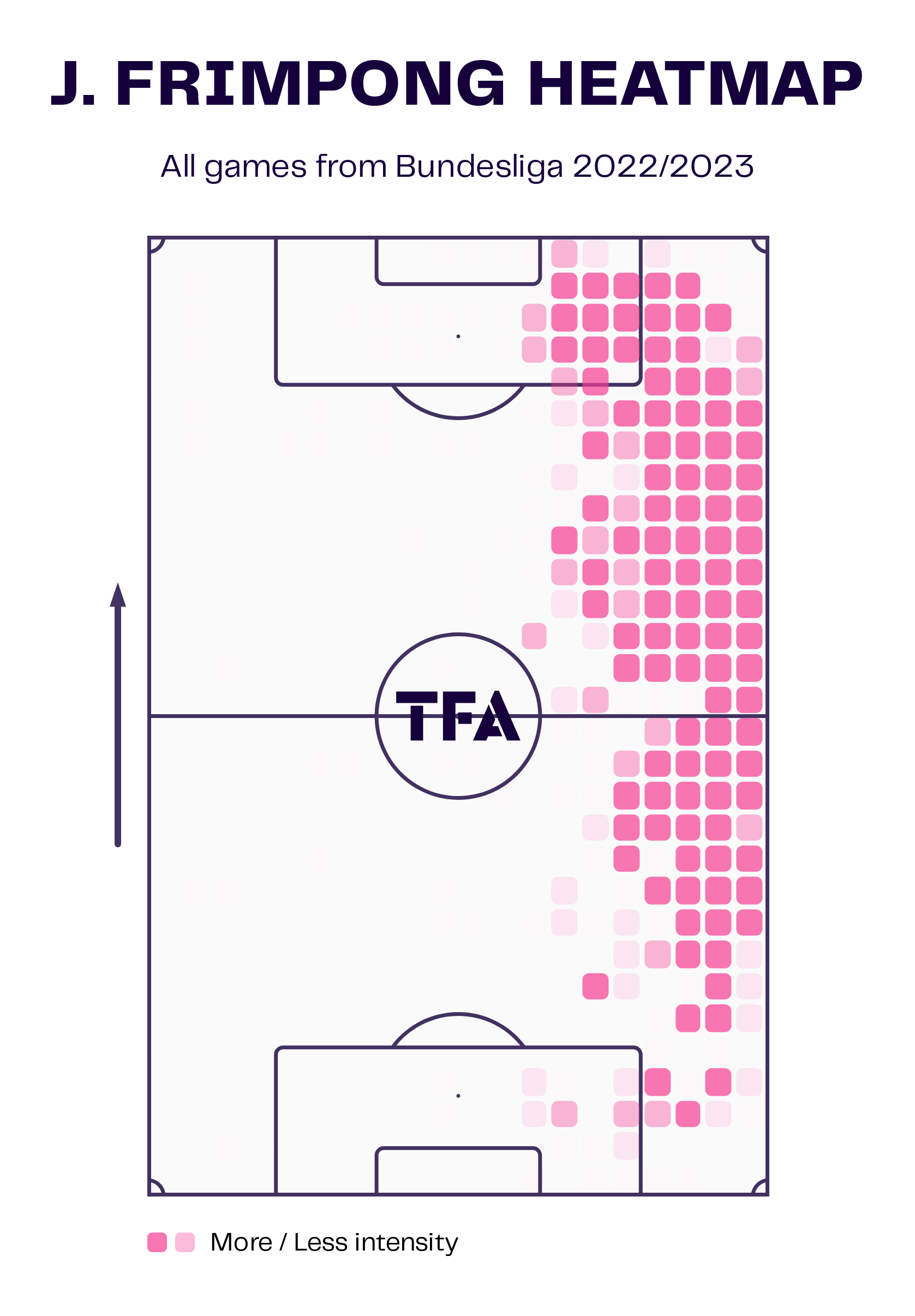
Dribbling Excellence
The 21-year-old has become one of the most promising young players on the scene, and his biggest standout quality is his explosive dribbling. He has amazing technical qualities, which allow him to keep the ball close to his feet at all times, and the manipulation to deceive the defenders and dribble past them. Frimpong’s low centre of gravity allows him to quickly change direction and speed while dribbling, which makes him extremely difficult to tackle.
The image below shows how frequently Frimpong runs with the ball, in tight, dangerous areas. In 15 games, Frimpong has carried the ball into the opposition box 50 times which is an extremely high number for a player who starts in the defensive line. We can also see how many carries he has made on the right flank, and these carries are vital to how Leverkusen can hurt teams and break down their defensive blocks.
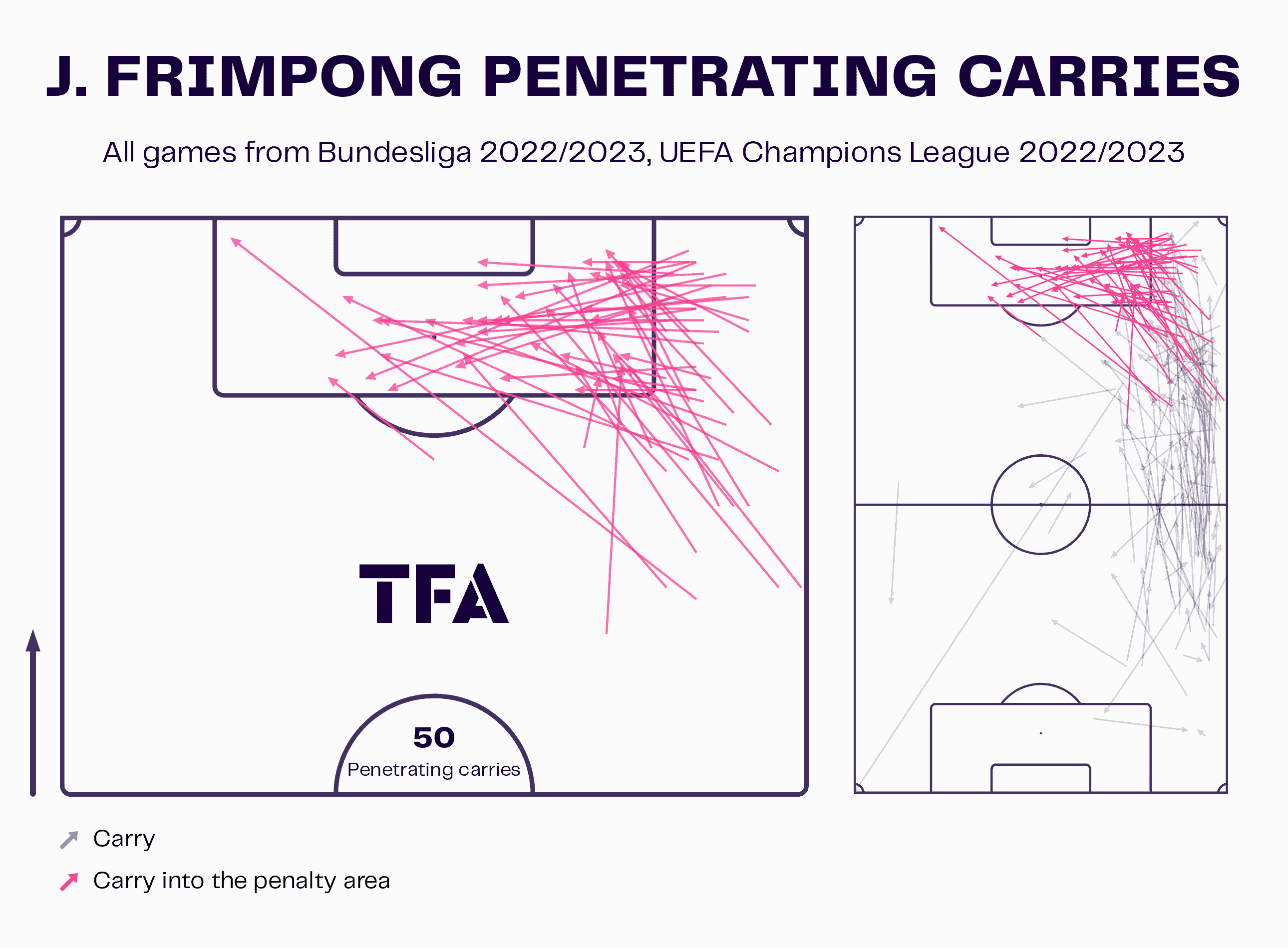
Jeremie Frimpong’s explosive qualities are most effective when taking on defenders in isolated 1v1s in wide areas. The wing-back has the running power to consistently knock the ball past his opponents and easily beat them by running on the outside where he has plenty of space. In areas closer to the box, defenders have more cover so this move can be less effective.
Frimpong at times has to manipulate the ball, or the opponent through close ball control and body movements to break down deep defensive blocks located in the 18-yard box. Frimpong is less consistent with this as he does not have the level of manipulation as some elite wingers. He can fool defenders with a drop of the shoulder, but can’t move the ball quickly enough to unbalance defenders and beat them with skill. While this can limit Frimpong, he is not usually found in these situations, as he usually hovers in wide areas where he can thrive in wide situations with space to knock the ball into.
Frimpong attempts 8.27 dribbles per game on average, with 55.8% of those being successful. This added threat that Frimpong can provide for his team is extremely valuable. Below, we can see an example of Frimpong beating his man on the outside, by knocking the ball into the open space from where he can drive into the box and cut the ball back to his teammate.
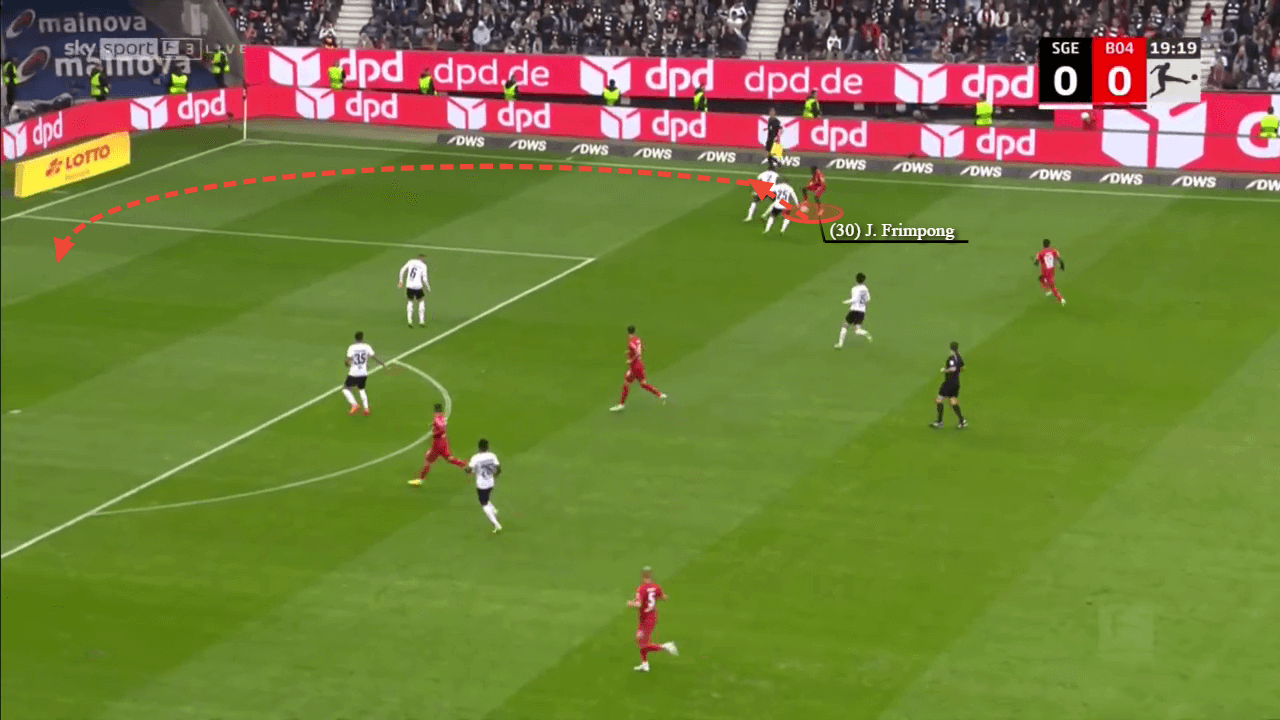
As a former Man City academy player, Frimpong has shown his excellent technical quality on numerous occasions. Below, the image displays Frimpong’s ability to turn with the ball, using the inside of his back foot while a defender is right behind him. Usually, players don’t have the bravery or awareness to turn with a defender right on them, however, Frimpong has the confidence in his control to turn and face up the defender, knowing that should the defender dive in, he can knock the ball past them as he has done in the example below.
The 21-year-old’s ability and awareness to take people on in deeper areas makes it dangerous for opposing teams to press him, as he is capable of beating the press, and taking advantage of open spaces left behind the back line.
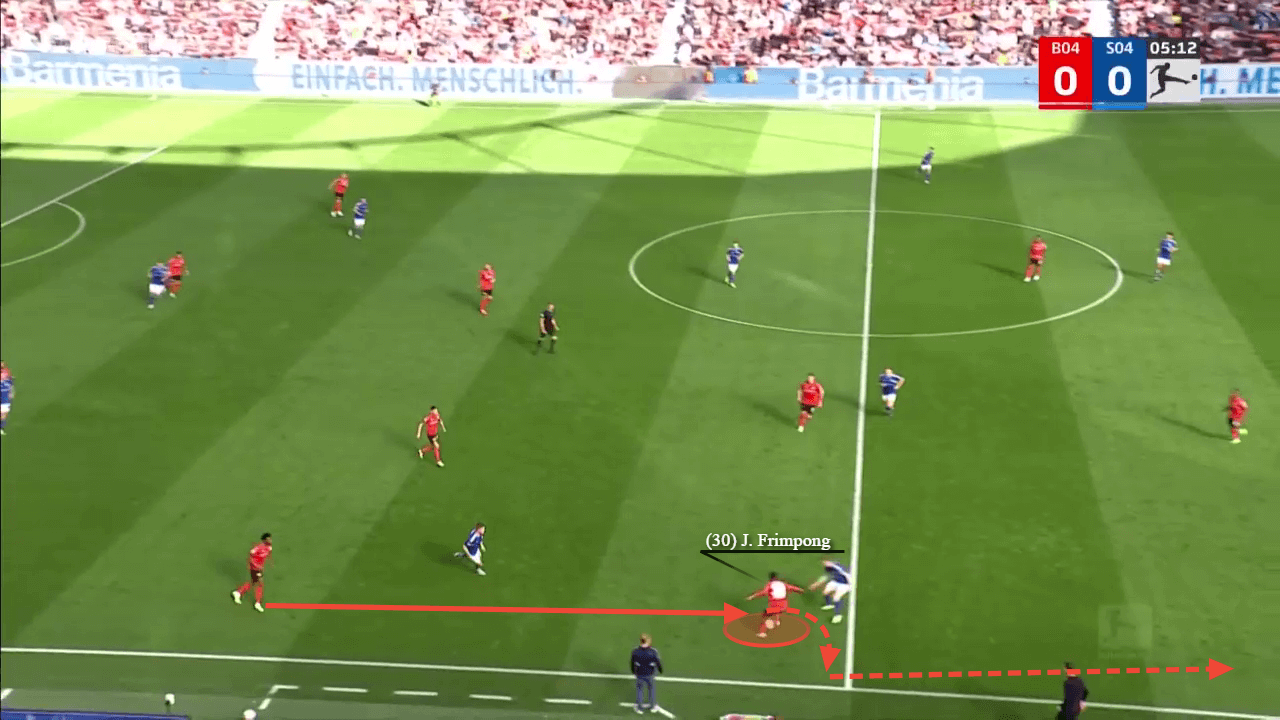
One final aspect that makes Frimpong such a skilled dribbler, is his use of body orientation to evade pressure from either side, making him unpredictable and harder to stop. At times, this can be an overlooked quality, as players who can only turn effectively in one way become easier to tackle.
While Frimpong hasn’t showcased his ability to turn to his left, he can shield the ball and turn using the outside of his right boot to attack space on his left side. This isn’t the most efficient way of beating players, and the fact he favours his right foot so much can sometimes make him too predictable, but the fact that he has a method of beating players on both his left and right, gives him an almost complete skillset as a dribbler in the final third.
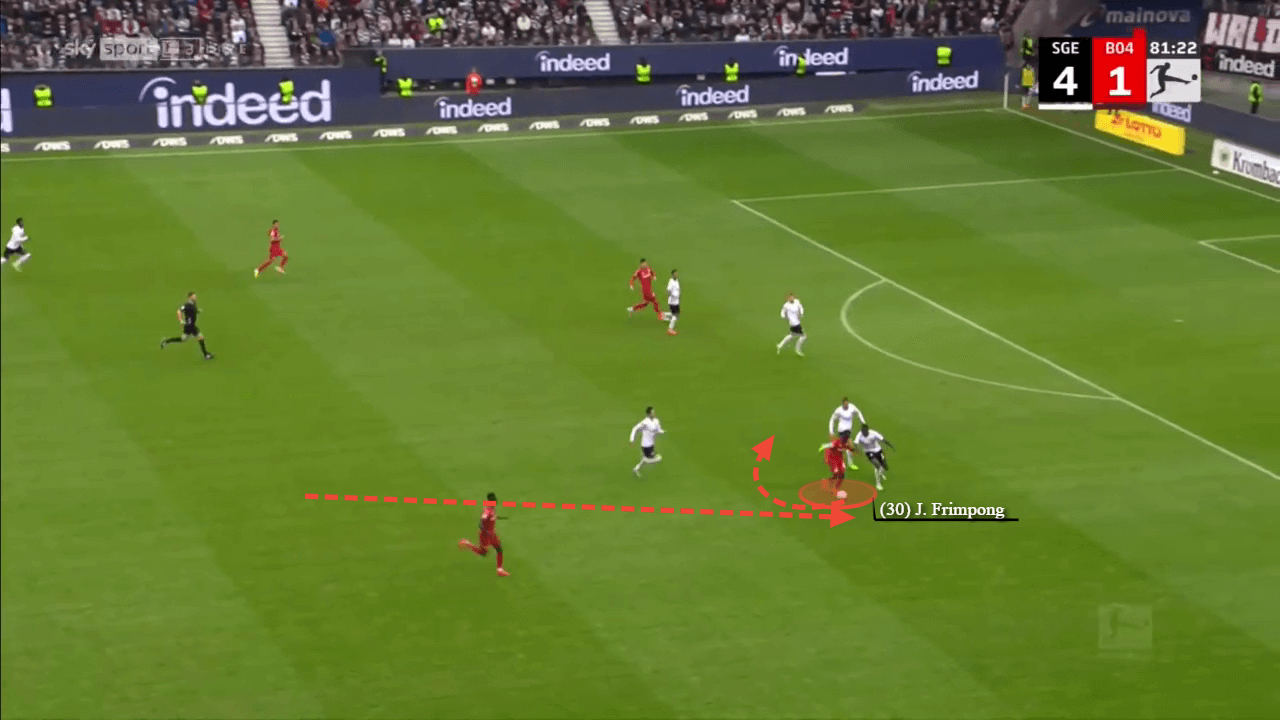
Finishing efficiency
One area in which Frimpong has majorly improved this season is his end product in front of goal. In 11 games, he has scored 5 goals, more than he has scored in every other season of his career combined. This goal-scoring streak is aided by a number of different factors. His role as a wing-back allows him to be more present in the opposition box, so therefore he will be more likely to find himself in dangerous positions from which he can score.
In addition, Frimpong has also acquired the skill of timing his runs at the back post, which has allowed him to score a number of easy chances. The xG map below shows how Frimpong has had three very easy chances at the back post. Being able to arrive at the back post at the right time is a skill which isn’t easy, yet reaps huge rewards. Making the run too early can mean that a defender will spot you and mark you, preventing you from receiving the ball.
On the other hand, arriving too late means that the ball will fly past the back post before you get there. Arriving at the perfect time means you are unmarked and six yards away from goal, with time to choose where to shoot and the goalkeeper will still be on the other side of the goal. This has allowed Frimpong to score numerous tap-ins that may seem easy to score, but are difficult to get to in the first place.
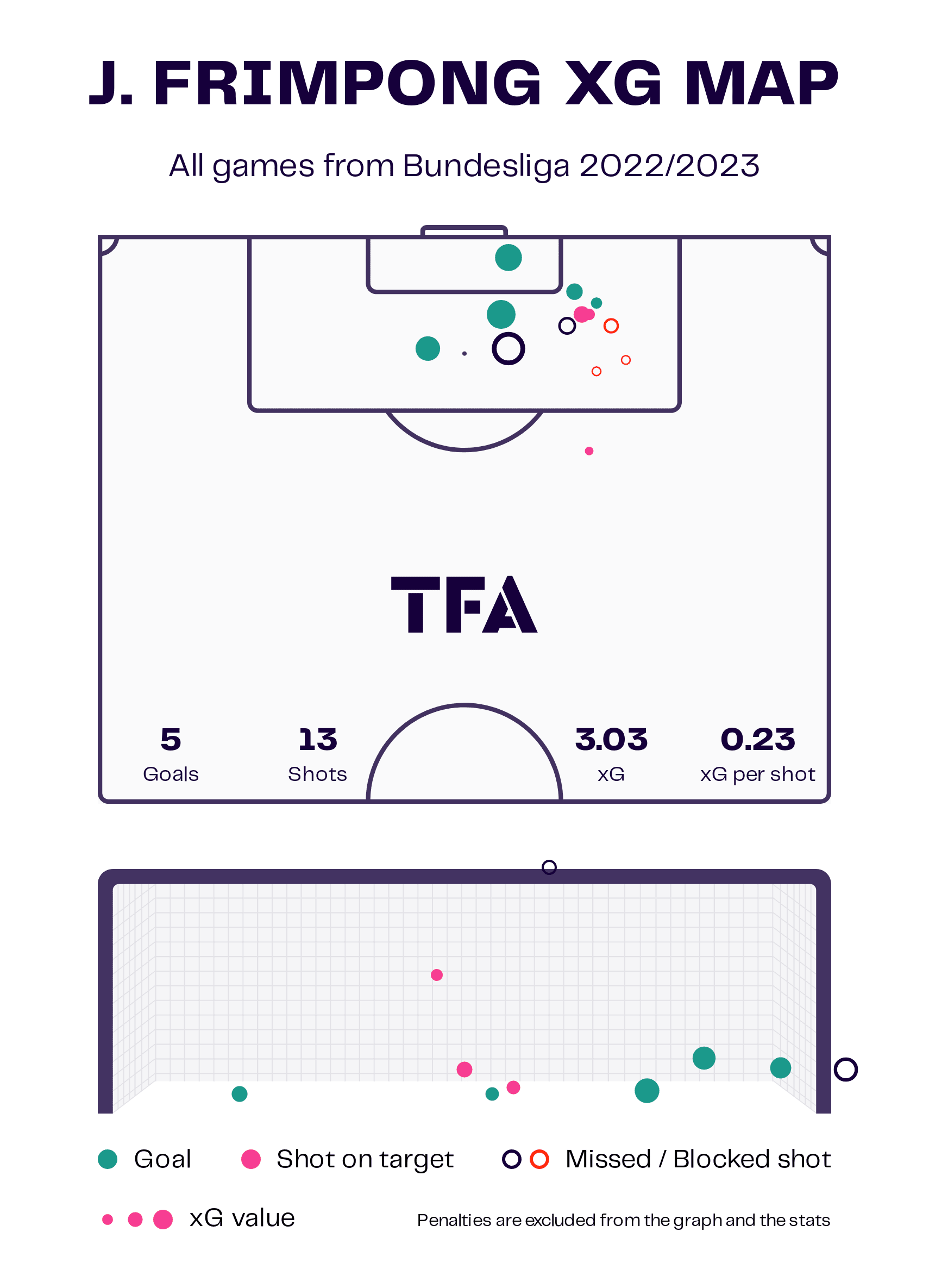
Another factor in Frimpong’s improved goalscoring numbers is his composure in the box. Players who don’t get shooting opportunities often usually rush their shots and as a result, they end up hitting it as hard as possible and missing the target. Frimpong is different in that regard as he looks up, recognises where the space is to aim for and uses the inside of his boot to powerfully pass the ball into his target.
This example below shows Frimpong looking up at the goal, locating the space in the far bottom corner, and Frimpong coolly slotting it while the keeper doesn’t even dive as it is out of his reach, due to slightly poor positioning.
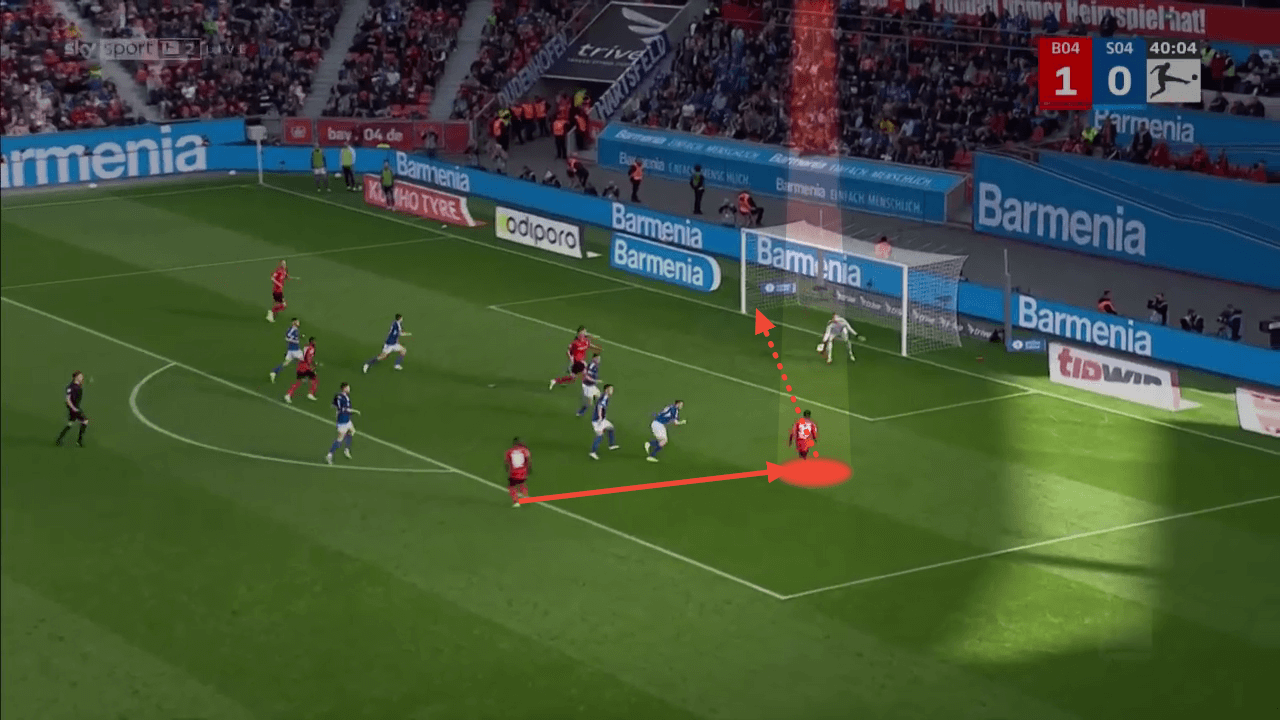
Part of what makes Frimpong clinical in front of goal is his ability to use either foot. He has scored 5 goals from 3.03 xG, showing that the young Dutchman is efficient in front of goal. The earlier shot map displays the 13 shots that Frimpong has taken, while 12 of those are at an angle from the right on his preferred foot.
However, on the one occasion where the ball is on the left-hand side of the goal, Frimpong has continued his shooting streak by placing it into the bottom right corner, with the ball yet again out of the keeper’s reach. The ability to use either foot effectively makes Frimpong even more dangerous in front of goal, although this could be a stroke of luck and we need to see this run continue over a longer period of time.
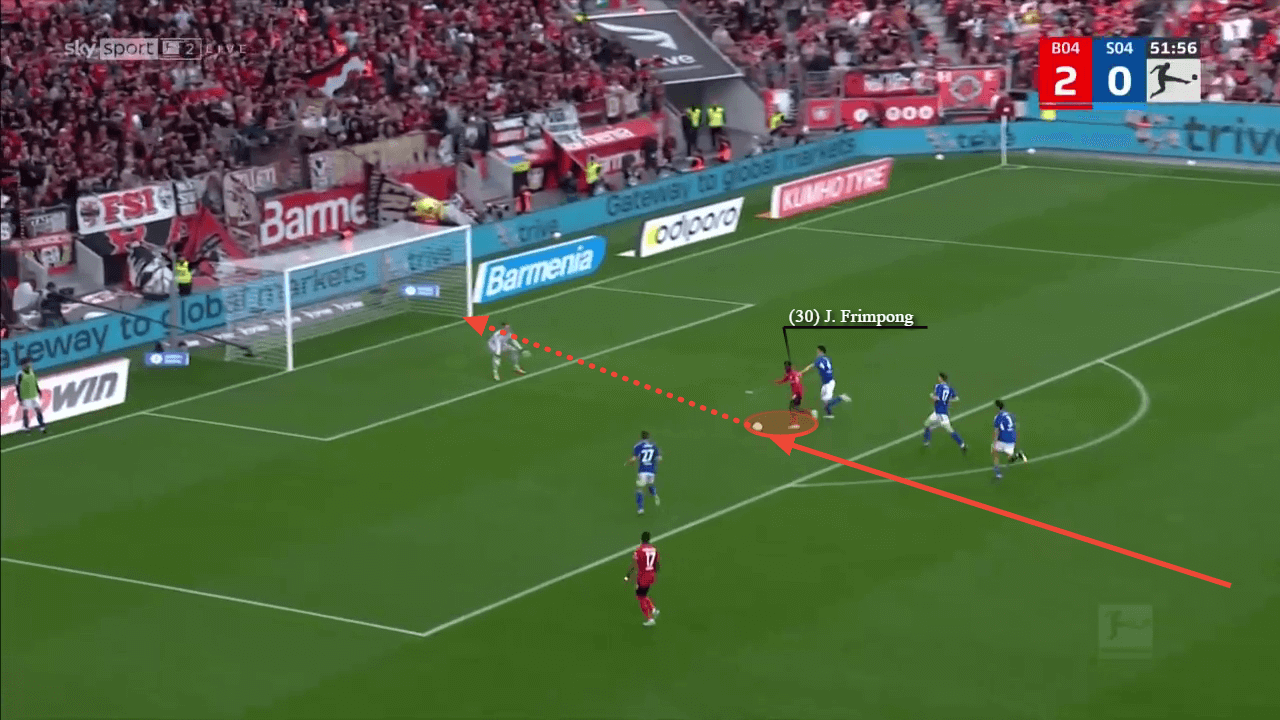
At times, you can’t even tell that Frimpong is a wing-back or a defensive player. The 21-year-old has displayed composure rarely seen at his age, and the ability to keep a cool head in front of goal when it isn’t something common for you shows just how confident and mentally strong Frimpong can be. This image below shows us Frimpong 1v1 against the keeper, with two defenders right behind him. However, rather than panicking or rushing the shot, Frimpong keeps driving with the ball, before taking the ball round the keeper, using his previously mentioned dribbling excellence, to give himself an open goal so he can yet again pass it into the goal.
Frimpong has shown a range of different finishing techniques and variations, which makes him an extremely dangerous wing-back. Hopefully, we can get to see different types of finishes such as volleys, laced shots or headers, but after only 11 games, Frimpong hasn’t had the chance to try some of these seeing as he is just a wing-back.
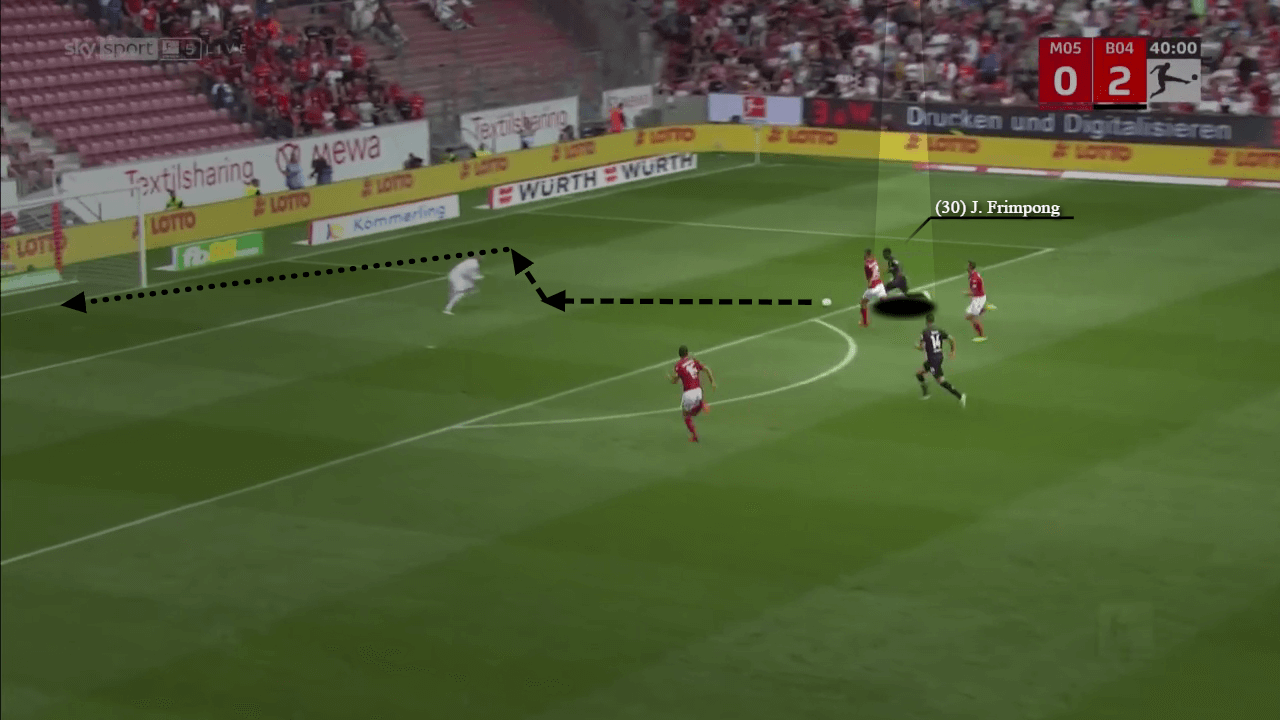
Wide Creation
One part of Frimpong’s game which could see more improvement is Frimpong’s ability to create dangerous chances from wide areas. We previously mentioned that the Dutchman has entered the box 50 times after dribbling with the ball, but only 2 of those occasions have ended up in an assist while we are still yet to see an assist in the Bundesliga. Right now, Frimpong’s dribbling has caused chaos for defences and allowed Leverkusen to progress up the pitch, however, the lack of threat from his passing will severely limit him and allow defenders to relax, knowing there is no danger of Frimpong receiving it in wide areas. Frimpong has struggled to accurately pick his teammates out with crosses in the air, as he has struggled to get the right power and trajectory to cause a threat.
Frimpong has still caused some threatening situations, as he has often looked for cutbacks to late runners arriving at the edge of the box, who are easier to find with the extra space that they are left with. The picture below shows Frimpong doing just that, as he cuts it back and his teammate has a dangerous shot which is saved by the keeper. Frimpong hasn’t yet created a dangerous chance from a wide area by whipping a cross or finding a defence-splitting pass, which is something he lacks. The ability to whip a cross may relate to his lack of ball-striking ability as he looks to place shots rather than hitting them as hard as possible.
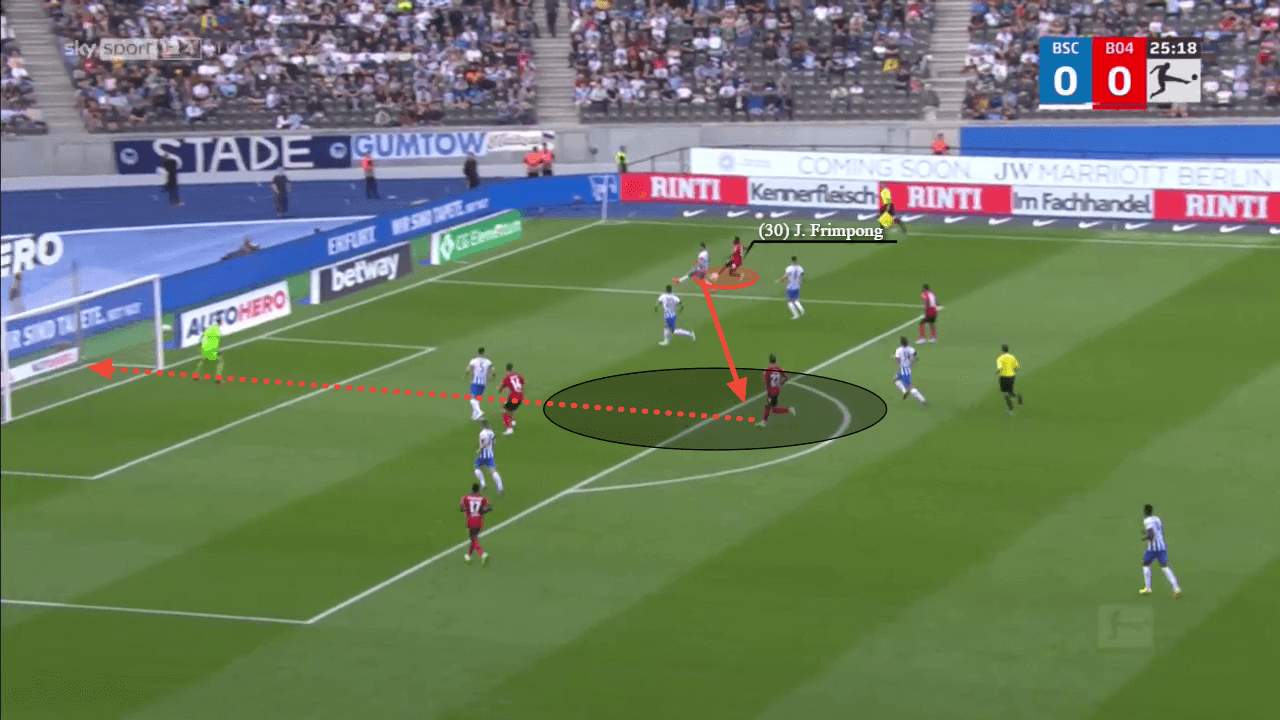
Defending Duties
Jeremie Frimpong is a wing-back, so he has to be able to carry out his defensive responsibilities first and foremost. The map below shows that Frimpong does carry out the defensive duties, with the shaded area showing that Frimpong is yet again equally productive on both halves of the pitch. In the opposition half, Frimpong can press high and intercept passes during the build-up while also tackling defenders in 1v1 situations, or when he counter-presses.
In the defensive third, his responsibilities are similar, although it is interesting that he has the same number of defensive actions in both boxes. This shows that Frimpong doesn’t have the responsibility to defend his box which, while it may be ok for a wing-back, he would never get away with as a full-back. Perhaps the biggest worry Frimpong may have is his smaller physical frame that could be exposed in aerial duels.
Frimpong is only 171cm tall, which is something that can be taken advantage of by opposing teams. The fact that Frimpong has a 30.8% success rate in aerial duels shows that this is a part of his game that he is weak at, but what may be more worrying is that this is all in the right channel, where he will usually come up against wingers who on average, aren’t as tall as classic number 9’s. This highlights a weak area in his game, where if he was to play as a full-back, he would struggle with crosses into the box and could be targeted by other teams’ strikers.
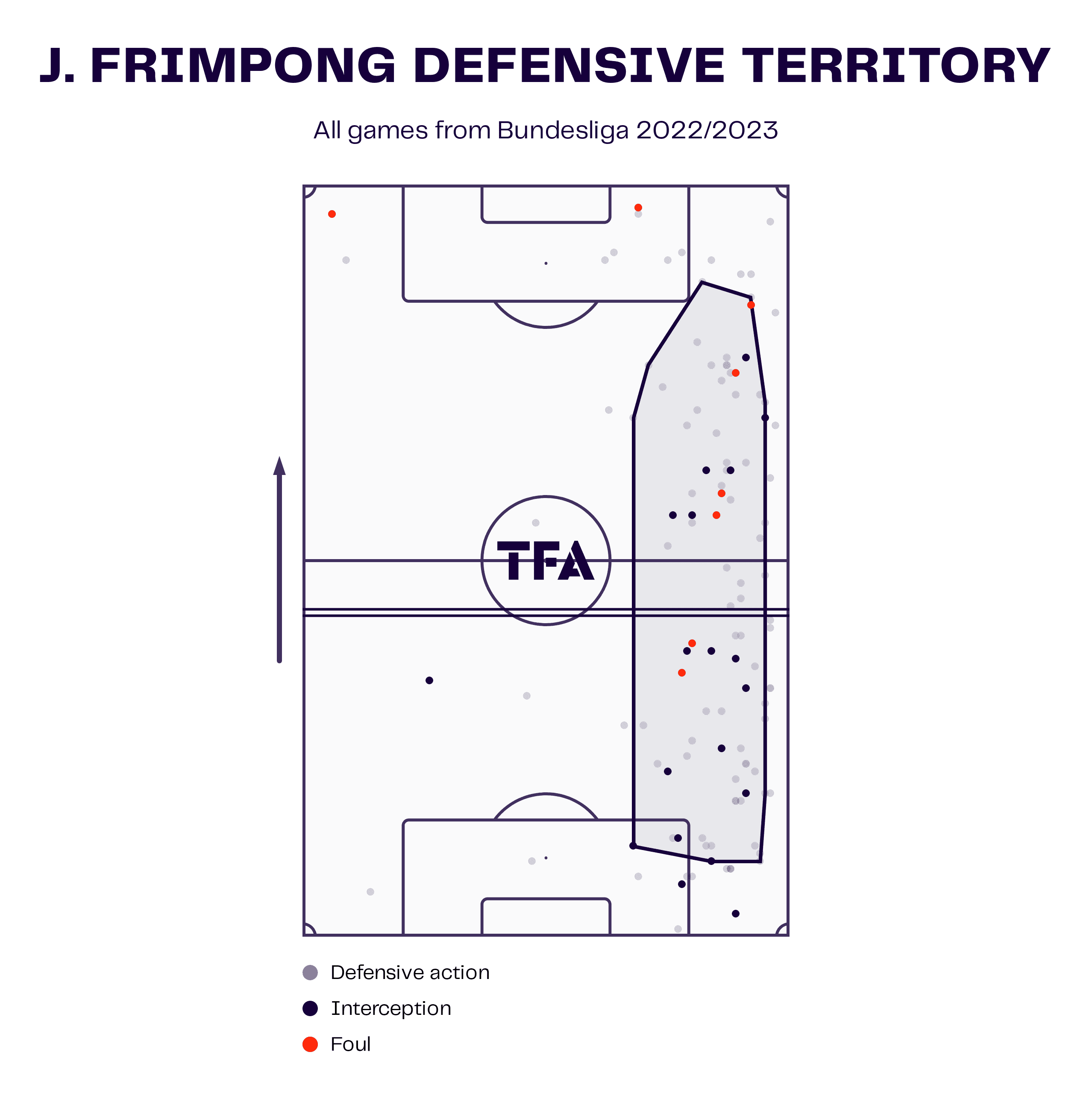
While Frimpong may be weaker in aerial duels, he makes up for it in 1v1 defending situations. Frimpong’s explosive pace has already been mentioned earlier, and this combined with his low centre of gravity allow him to be a good 1v1 defender. Frimpong doesn’t have to dive into tackles as he can wait for attackers to try to beat him for pace, which Frimpong knows is a race he will win every time. This image below shows the opponent running at Frimpong at full speed, and even though the 21-year-old has his back to goal, he wins the race when the ball is knocked past him and into the direction of the goal.
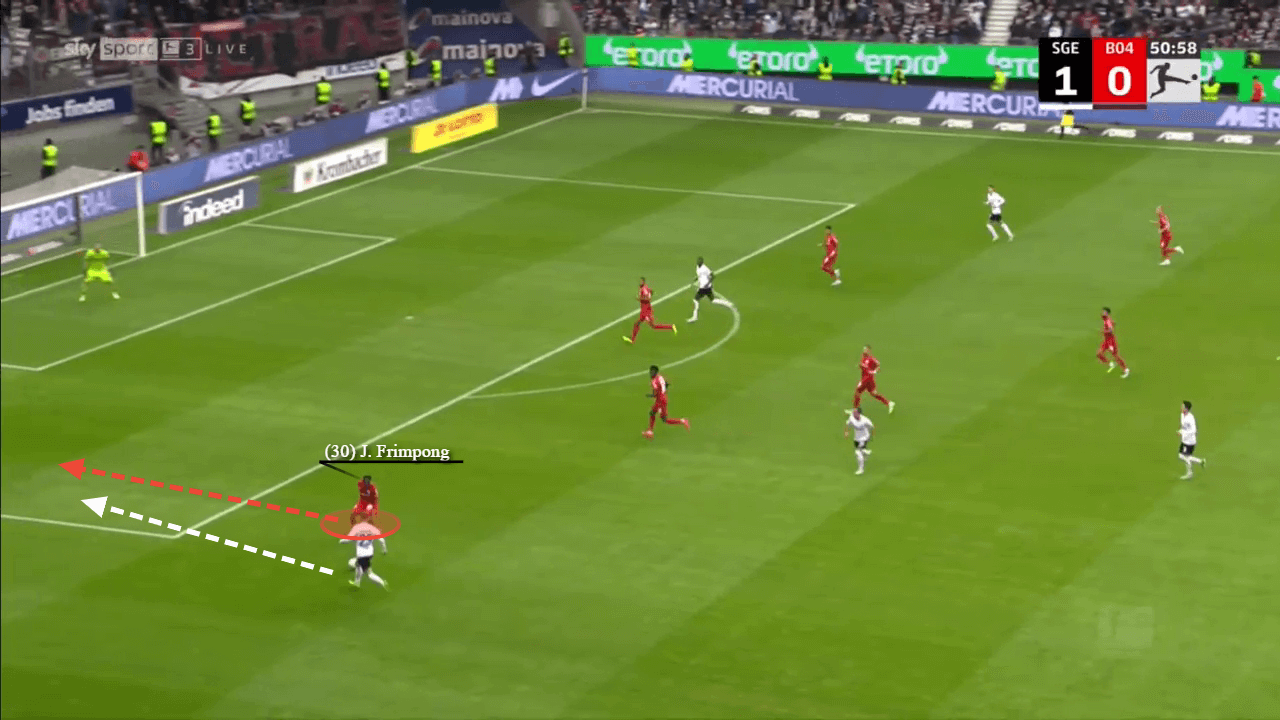
Conclusion
In conclusion, this tactical analysis has summarised just why Frimpong is an exciting prospect, and it is justified why some big clubs have been rumoured with the young man. His explosive dribbling and great movement in the box would make him a big goal threat for any side that use wing-backs, while a full-back role is less suitable. This works for his country as well, after they’ve been using a 3-5-2 formation for the past number of years.
Furthermore, Frimpong could be a breakout star at the World Cup, after being named in the provisional squad, although it is unknown if he will get selected, and he has big competition from Denzel Dumfries if he wants to make the right wing-back spot his own.






Comments